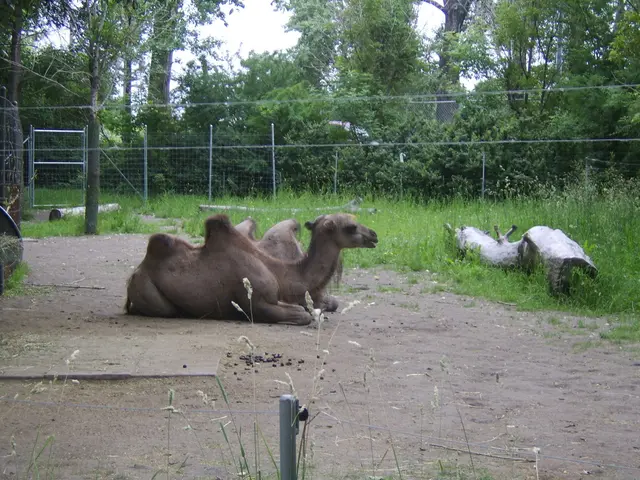Immense Saharan Dust Plume Heading Towards Florida
A Load of Saharan Dust Heading to Florida: What to Expect
Get ready, Florida! An impressive cloud of dust from the Sahara is drifting westward over the Atlantic Ocean, aiming directly for our sunny state.
The thickest part of this African dust plume has already reached the Caribbean and might arrive in Florida by midweek, as predicted by the National Weather Service in Miami. Upon its arrival, expect a drier local climate, questionable air quality, and shimmering sunrises and sunsets, according to meteorologists.
Just before noon on Monday, the NWS office in San Juan, Puerto Rico shared that peak concentrations of Sahara dust were rolling into the area and were forecasted to arrive later in the day. The agency has issued multiple air quality alerts, warning that inhaling dust can irritate respiratory systems and aggravate allergies, asthma, and other respiratory conditions.
These minuscule particles can also trap heat near the ground, consequently, NWS San Juan has issued a heat advisory that will continue through Tuesday. Southeasterly winds combined with the effects of the dust cloud will hold temperatures above normal in numerous coastal and urban regions, the agency stated.
By the end of last week, a svelte curtain of dust was already dispersing over Florida, as shared by NWS Miami meteorologist Ana Torres-Vazquez with Scientific American. By midweek, a denser, more substantial cloud of dust will descend upon the state, though meteorologists predict it will be patchier than the current conditions in the Caribbean. Some patches may reach parts of the Gulf Coast by the end of the week, as per The Weather Channel.
Formally known as the Saharan Air Layer, or SAL, this massive collection of exceedingly dry, dust-laden air develops each year from late spring to early fall, mainly due to ripples in the lower to middle atmosphere, better known as tropical waves, which track along the southern edge of the Sahara Desert, hoisting colossal amounts of dust into the atmosphere, as explained by Jason Dunion, a NOAA meteorologist in a 2020 interview.
Every three to five days, the SAL moves over the tropical North Atlantic Ocean in what's known as an "outbreak." This activity usually peaks from late June to mid-August, and during this peak period, outbreaks spread farther west. Occasionally, an SAL will travel over 5,000 miles, crossing multiple Gulf Coast states, including Florida to Texas. That's what's currently happening, as confirmed by NOAA, which tracks the SAL using its GOES-16 satellite.
The arrival of this SAL coincides with the onset of the Atlantic hurricane season, which officially started on Sunday, June 1. The warmth, dryness, and potent winds associated with this dusty air mass have been shown to disrupt tropical cyclone formation and intensification, as explained by Dunion. Thus, the SAL typically hinders hurricane development.
However, meteorologists are already monitoring an area along the southeast coast for potential subtropical or tropical development. AccuWeather predicts that, over the next 10 days, dry air from the SAL will alternate with moist air over the Caribbean and off the east coast of Florida. This may cause a zone of moisture to develop from South Florida to the Bahamas and Cuba early in the week, possibly delivering several inches of rain and thunderstorms to the area. Although the risk of tropical development is minimal, heavy rain could result in minor coastal flooding, rip currents, and rough surf from mid to late week, as per AccuWeather's reports.
On the upside, Florida residents—and maybe even those in other Gulf Coast states—can enjoy some particularly awe-inspiring sunrises and sunsets this week, owing to the SAL. That's because high concentrations of dust make the red and orange hues during low-angle sunlight even more brilliant as they pass through the atmosphere.
The SAL could linger over the southeast for an extended period, although it's uncertain when the dust will finally dissipate. Meteorologists will be keeping a close eye on how the SAL affects air quality, visibility, and the early days of hurricane season.
Enrichment Data:Explanations:
Expected Impacts and Duration of the Saharan Air Layer (SAL) in Florida and the Gulf Coast
Respiratory Health Concerns
- Respiratory Distress: The high concentration of dust particles in the SAL may cause respiratory issues such as coughing and sneezing. These issues could worsen existing conditions like asthma[1][2].
- Irritated Eyes and Throats: Aside from coughing and sneezing, the particles can also aggravate eyes and throats, causing irritations[1].
Visual Effects
- Scintillating Sunsets: The dust particles in the SAL scatter sunlight, creating striking, alluring sunsets[1][3][4].
Weather Patterns and Hurricane Formation
- Suppressed Hurricane Development: The dry, warm air in the SAL acts as a "hurricane killer" by inhibiting hurricane formation and intensification during the Atlantic hurricane season. This offers a respite during the six-month hurricane season[3][4].
Duration
- Arrival and Persistence: The SAL is expected to reach Florida and the Gulf Coast by late this week and throughout the weekend. It may stay for several days, with the initial wave potentially followed by a larger, denser plume[2][4].
Geographic Scope
- Affected Regions: The impact will be significant in Florida, Louisiana, Alabama, and Mississippi. The dust cloud will span approximately 2,000 miles across the Caribbean and the Atlantic Ocean[2].
- The future SAL, currently moving over the Atlantic Ocean, might cause air quality concerns as it is expected to reach Florida by midweek, potentially irritating respiratory systems and exacerbating existing conditions like asthma.
- Upon arrival in Florida, the SAL could lead to a heat advisory, keeping temperatures above normal in numerous coastal and urban regions, as stated by the NWS.
- In addition to air quality and temperature concerns, the SAL might also bring awe-inspiring sunrises and sunsets to Florida due to the high concentration of dust particles scattering sunlight.
- As the SAL moves westward, it might also impact the Gulf Coast, reaching parts of the region by the end of the week, according to The Weather Channel.




